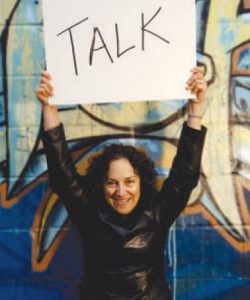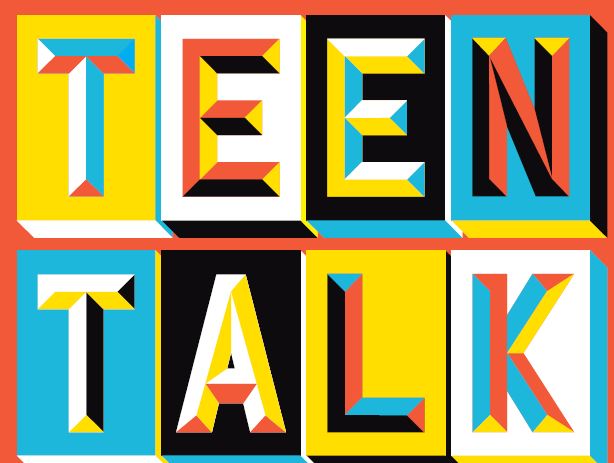Rather than accusing teens of degrading the English language, linguist Dr.Sali Tagliamonte calls them “language innovators”—and says the words we choose reveal a lot about who we are.
by Natalie Kallio
What can often feel like a divisive element between generation sbecame a point of fascination for Sali Tagliamonte. The mother of five children with almost 20 years between the first and the last, Tagliamonte recalls that one of the best pieces of parenting advice she and her husband received was to listen, not speak—not an easy feat for any parent, let alone a sociolinguist.
But listen she did, discovering an unexpected “linguistic laboratory” of teen talk in the process—”that’s SICK, mom,” “LOLS,” and other “STUFF”—at her very own kitchen table. She had a hunch something dynamic was happening; indeed, what developed satisfied her “principle of curiosity” (her personal bar for research worthy of the “painstaking labour” of collecting, counting, coding, and analyzing).
In addition to working as a sociolinguist, Tagliamonte is a Trinity Fellow and serves as Professor and Chair of the Department of Linguistics at the University of Toronto, Canada Research Chair in Language Variation and Change, and Fellow of the Royal Society of Canada. Between her children, their friends and later, their partners buzzing about her busy household—16 at the dinner table was not unusual—Tagliamonte cultivated her own home language lab. It allowed her to observe her kids in a petri dish of language development from childhood to early adulthood over almost two decades.
All this eavesdropping provoked a shift of her “language detective” lens from the older generation (on which her previous research focused) to the next generation, which she captures in her book Teen Talk: The Language of Adolescents.
Tagliamonte set out to capture how teens speak to each other, be it telling stories about the weekend or those mysterious—and often guarded—late-night internet messaging threads. As both researcher and parent, she knows that teens who are aware they are under adult observation may alter their speech accordingly (POS: “parents over shoulder”). Tagliamonte avoided the POS effect by enlisting her undergraduate students as peer researchers, allowing her to fall back as Sali the undetected SOS (“Sociolinguist over shoulder”).
20 years, millions of words
Since student interviewers use language in the same ways as their peer subjects, this research method fostered the comfort and familiarity Tagliamonte sought in capturing how teens really talk. Over 20 years, she and her students compiled representative corpora of teen language use: databases of millions of words from hundreds of Torontonians, ranging from pre-adolescence through early adulthood.
These resourceful co-conspirators collected personal narratives from their friends and siblings and even contributed their own anonymized emails, text messages, and instant messaging threads (the Holy Grail of teen talk). To study individual change, one corpus amasses over 100,000 words of conversation between one teen, “Clara” (interviewed regularly from age 16 to 32), and her sister.
Everything old is new again
More specifically, Tagliamonte unpacks many of the more frequent (and frequently maligned) terms—LIKE, SO, YOU KNOW, JUST, WHATEVER—exploring when, where and why they gained popularity, what’s innovative about how young people use them, and the functions that they perform.
This language detective’s sleuthing delves into everything from the ascendancy of weird for all things strange—including the influence of those “weird”-titled comics of the 1950s—to the fascinating linguistic acrobatics of so. She also demonstrates that most of these words and phrases are neither new nor the exclusive verbal territory of teens. To hear her in action, check out her delightful schooling of Michael Enright in their 2017 CBC Sunday Edition radio interview, “Think Again—So…why do we start sentences with the word ‘so’?”.
And while the growing frequency of like was not news to Tagliamonte, under her magnifying glass she detected and dove into teen use of like as a quotative verb: she’s like, “This book is so cool,” and I’m like, “I know, right!” Such usage indicates language innovation in action, as teens push the boundaries of its capabilities: “I’m like so happy” and “she’s like weird” and “mom’s like, ‘enough with the likes!’” At some point, using like in this way will probably sound old-fashioned and the next generation will replace it with something new (or recycle something old).
Deceptively innovative—or whatever

According to Tagliamonte, precisely what teens often do with language falls into the category of linguistic innovation. Consider whatever as a stand-alone—dismissive, annoying, frustrating, right? Clearly, teens tend to make use of whatever as a linguistic shoulder-shrug, a discursive head-shake, an “I DON’T CARE” (and a highly effective one at that).
And what about all that superfluous speech teens use, such as beginning a sentence with “OH YEAH OK”? Surprisingly, those placeholder terms may serve many functions at once: the oh gets the listener’s attention, the yeah acknowledges what they may have recently said, and the OK tells them whether the speaker agrees or disagree with them. What about lol (laughing out loud), spoken as “loll” (phonetically) or spelled out L-O-L (acronym)? Is anyone actually laughing out loud? Most likely not, but lol implies “that’s funny” and exactly how funny, with its own unique set of superlatives: rolling on the floor laughing (ROFL), laughing my f-ing ass off (LMFAO), or even the antithesis, simply not that funny (LOL as sarcasm).
Also worthy of note is teens’ frequent use of “I don’t know”: They declare it, pepper their stories with it, abbreviate it phonetically (IONO), text it (IDK), and some even hum it (DA-DA-DUM). At a glance, it would appear teens admittedly don’t seem to know much at all. Now examine what they are saying under Tagliamonte’s linguistic microscope: Obviously sometimes they don’t know, but often these placeholders essentially mean “I do know” and, in many cases, soften the blow of what is known (e.g., “I don’t know. It’s just ugly”).
Delving deeper, this phrase isn’t the invention of the contemporary teen or even a recent phenomenon; rather, according to Tagliamonte, it reached an apex in the 1920s that exceeds current usage. Through the decades, linguistically the phrase has lost its connection to the original meaning of not knowing as language has changed. The next time you hear “I don’t know” from a young person, pay attention to what follows … do they know? And if they do, are they erring on the side of politeness in a critique (perhaps of that hipster’s ugly sweater)?
The bee’s knees, groovy or sick: Seeking distance from adults
A linguistic detective can even use how we communicate to determine our approximate age, for example, by how we intensify meanings. Would you say ice cream is very, pretty, or really nice? So nice? If you use very, you are likely older, so means you’re younger, and pretty and really put you somewhere in the middle (but if your ice cream is well or full nice, you’re probably studying too much Old English).
Of course, every generation seems to blame teens for corrupting’the English language. This stance is nothing new, nor is teens speaking in ways that seems alien to adults (that’s the point!). Adolescents seek to be in with their peer group while being out with adult-speak, and their language seeks distance—through shock, play, creative recycling, profanity, in-crowd connotations— from the mundane and conventional.
Consider synonyms for good: to denote positivity, teens of the 1920s may have used “the bee’s knees,” while “groovy, man” is associated with the flower children of the 1960s, and Tagliamonte’s teens are like, “That’s sick, mom.” Think of all the words you may use—or used to use—that might make someone from a different generation roll their eyes or clutch their pearls. Whatever, right?
Teens as movers and shakers of language change
Tagliamonte passionately defends teenagers’ speech patterns and is quick to dispel myths that they are the harbingers of the death of “proper English.” Rather, she is acutely aware of their role as innovators, the movers and shakers of language change, and evolution. She also asserts that while you may hear a lot of “like” and “so” and “lols” in the halls of Trinity, you are unlikely to find them in students’ essays or even their emails, as demonstrated by Tagliamonte’s comparisons of her subjects’ talk, computer mediated communications and essays. They know how to use “proper” language when and where they need to (which is why covert methods of compiling sociolinguistover-shoulder research is so integral to this research).
As Tagliamonte makes clear throughout Teen Talk, linguistic innovation and change occur most profoundly during adolescence and young adulthood. As children, we acquire the language of our caretakers; by early adulthood, our language tends to stabilize and remain generally constant throughout our lives.
It is in adolescence where most of our creativity and innovation with language and grammar takes place. It is a period of creative and exciting instability and incorporation in which communication takes on new forms, adopts new words, and develops rapidly alongside our peers’ (and along with our bodies and brains, thanks to our hormones).
Those who used all those likes, sos, and whatevers as teens will likely continue to use them throughout their lives and in turn will sound so very old-fashioned to the next generation. Teens are renewing and refashioning words, phrases, forms and meanings, and Tagliamonte champions many features of teen language, revealing them as innovative bellwethers for the future rather than the demise of the English language—and we are wise to pay attention.
Spring 2019


Sorry, comments are closed for this post.